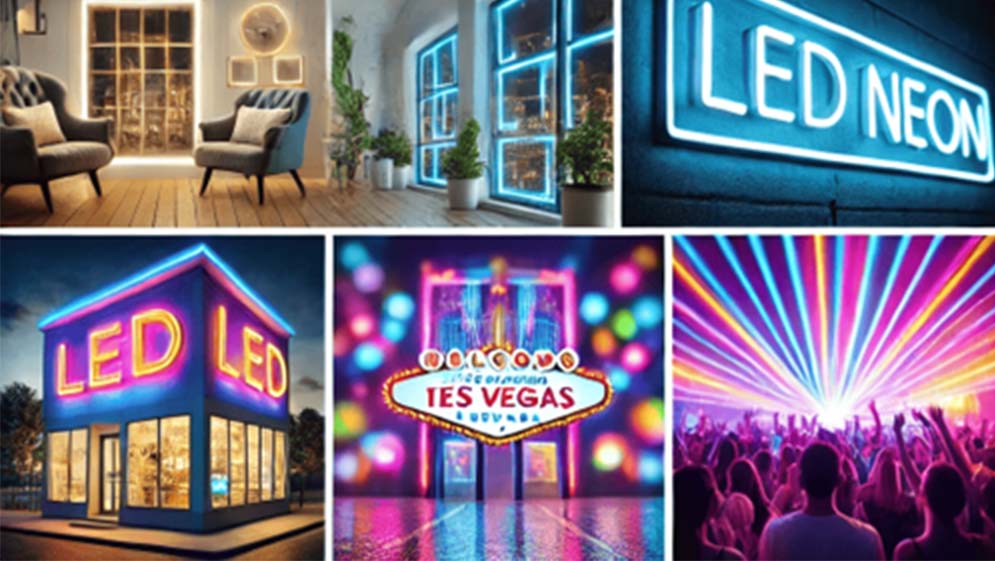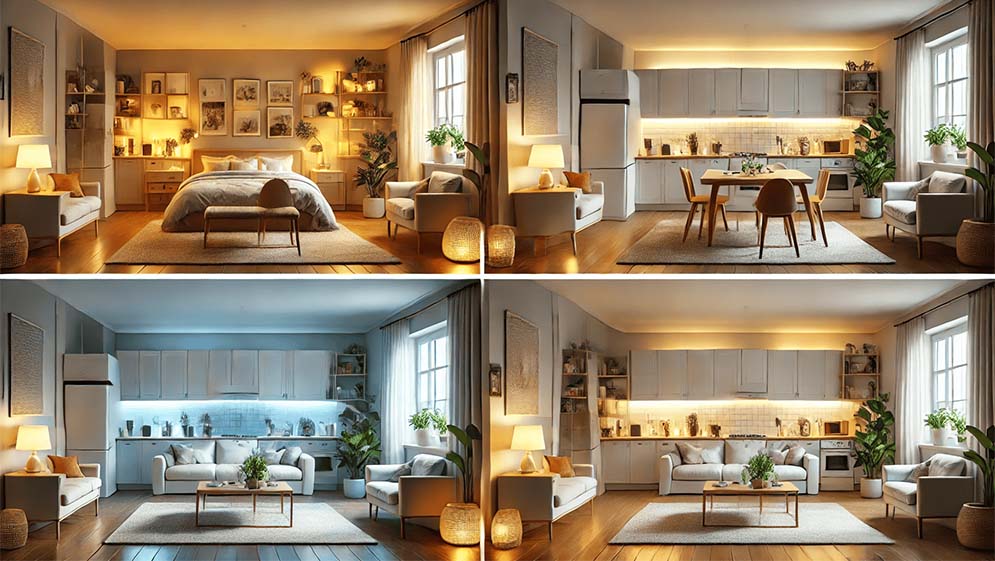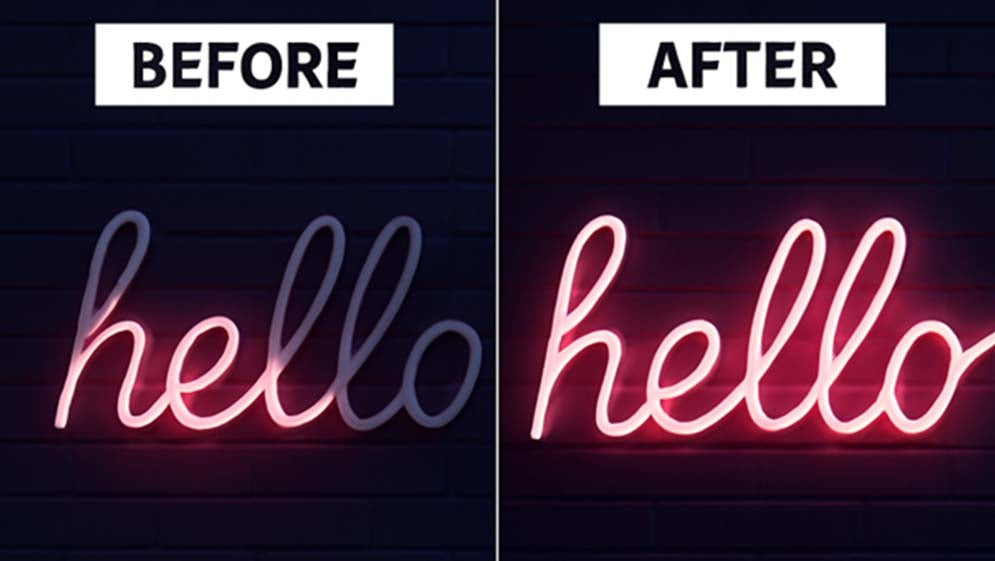Neon light bulbs have been captivating us for years with their vibrant and colorful lighting that adds joy and energy to indoor and outdoor areas. In recent times the traditional glass neon lights have been replaced by energy efficient LED lights. In this post we'll discuss how LED neon lights operate and how they differ from the traditional neon light, and how they've evolved into the most popular solution for lighting today.
Understanding Neon Lights
What Are Neon Lights?
Neon lights are one type of gas discharge lamp that produces illumination by passing electrical energy through neon gas. Once the gas has been ionized, it produces glowing colors. They first came to light at the beginning of the 20th century, and were subsequently renowned due to their vibrant, dazzling appearance, especially in signage as well as advertisements.
History and Evolution of Neon Lights
The first time that neon lamps were discovered in the early 1900s, when scientist Georges Claude first demonstrated the light bulb at the Paris Motor Show. Through the years they have become a symbol for modernity and technological advancement, frequently used in advertising, signage and in the field of art.

The Basic Working Mechanism of LED Neon Lights
LED neon lights function by employing a collection of small and energy-efficient LEDs, which are placed on the flexible circuit board that is later enclosed within the silicone tube. Once power is provided into the circuits, LED release luminescence. The tube's silicone diffuses the light uniformly, resulting in a glowy, smooth effect that resembles neon lights from the past.
Key Components of LED Neon Lights
The principal elements of an LED neon light comprise:
- LED Diodes: They are light emitting elements that produce a glowing.
- Flexible Silicone Tube: The tubing protects the LED, and also provides the light effects of neon.
- Power Supply: Transforms electrical energy into an appropriate voltage for LED.
- Controllers: Let you customize color, brightness as well as effects.

How Do LED Neon Lights Work?
The Working Principle of LED Neon Lights
The principle behind LED neon lights is the utilization of light emitting diodes (LED) that produce illumination. LED are devices made of solid state which emit light whenever they are exposed to electrical energy. their surface. This is a step-by-step guide on the way LED neon light’s function:
a) Powering the LED
The initial step of the procedure is to provide electricity to the LED's neon light. Power supply transforms the alternating current (AC) that is supplied by the outlet to direct current (DC) which is the power LEDs need. The power supply makes sure that the current and voltage are controlled so that LED are not exposed to excessive current, which can result in damage.
b) Current Flow through the LED Chips
When the power source delivers DC energy to the LED inside the tube that is flexible, flow of current is confined to each LED chip. An LED chip is constructed of semiconductor material that lets the current flow only in one direction.
c) Emission of Light
When the power source delivers DC energy to the LED inside the tube that is flexible, flow of current is confined to each LED chip. An LED chip is constructed of semiconductor material that lets the current flow only in one direction.
d) Diffusion of Light
The light that is emitted by the individual LED could appear to be smaller, focused spots. In order to create a smooth, glowing glow that is similar to that typical neon light bulbs The LED strip is usually enclosed by the form of a diffuser. The diffuser disperses lights and softens the appearance of the LED and removing hot areas.
e) Flexibility and Shape
The flexible nature of the silicone tubing to make LED light bulbs is considered to be one important advantage over traditional neon lights. In contrast to rigid glass tubes LED neon light bulbs can be bent and shaped into various shapes without degrading the effect of lighting. This flexibility permits creating custom-designed forms, designs, and other decorative items.

Understanding the LED Diode in Neon Lights
LED diodes form the basis of LED neon light. They are semiconductors which emit light whenever they are subjected to electrical energy. The hue of illumination is determined by the material used to make the diode. The most common colors being blue, red green, white.
The Role of Voltage in LED Neon Lights
LED neon lights run at lower voltages, which makes the lights more secure and energy efficient over traditional neon lighting. The voltage is converted into an appropriate amount through an energy source, which ensures that LED get the correct amount of energy to ensure optimal efficiency.
How Color and Brightness are Controlled
The LED lights are bright and the color can be determined by the use of RGB (Red green, blue) LED. Through adjusting the brightness of each color channel you can get a complete range of colors. Also, brightness is adjustable via dimming controls, which allow for customizing the lighting.

Advantages of LED Neon Lights Over Traditional Neon Lights
Durability and Strength of LED Neon Lights
LED neon lights are much stronger than traditional equivalents. The silicone tubing is flexible and protects the LED and makes it impervious to impacts as well as breakage. This makes LED neon lights suitable for outdoor and indoor use.
Energy Efficiency and Cost-Effectiveness
LED neon light bulbs use lower energy consumption than traditional neon bulbs. They have the same degree of brightness, but consume only a tiny amount of power. This results in less energy costs and a lower environmental impact.
Safety Benefits of LED Neon Lights
These LED light bulbs are safer than the traditional neon light. As they operate at lower voltages, they have less danger of electrical dangers. In addition, the silicone case of LED neon light bulbs isn't susceptible to breaking just like glass, which makes it safer to work with and set up.
Versatility in Design and Application
LED neon lights are extremely adaptable. They are able to be utilized for numerous things like lighting up the interior of homes, constructing signposts, lighting up occasions, or huge lighting installations. The flexibility of these lights makes them an ideal choice for every environment, with the ability to create unique and personalized lighting concepts.

Applications of LED Neon Lights
Common Uses in Home Decor and Interior Design
LED neon light bulbs have grown into an increasingly popular option for home design, being used in every aspect from lighting accents to customized signage. The flexibility of LED lights makes them suitable for designing custom neon styles for living spaces as well as bedrooms and kitchens.
LED Neon Lights in Outdoor Signage and Advertising
Outdoor advertising and signage are also benefiting due to the popularity of LED lights. These lights are commonly used in billboards and storefronts as well as other commercial areas because of their light intensity endurance, long-lasting, and energy effectiveness.
LED Neon Lights in Events and Festivals
LED neon lights are often employed in festivals or events and their vivid colors and custom effects are perfect for creating a thrilling ambience, be it in the concert hall, an outside venue, or the night market.
Industrial and Commercial Uses of LED Neon Lights
LED neon lights are extensively employed in commercial and industrial environments, such as factories, warehouses, and even airports. Their long-lasting durability and minimal maintenance needs makes them a great alternative for such settings.

How to Choose the Right LED Neon Lights for Your Project
1. Factors to Consider (Color, Size, Power Supply, etc.)
If you are choosing LED neon lights, you should consider aspects including color, dimensions as well as the power source required for your project. It is also important to think about the purpose of your project (indoor or outdoor) as well as the particular specifications for the design.
2. How to Install LED Neon Lights Properly
Installation is simple enough However, it's important that you follow the directions of the manufacturer attentively. Use the correct electrical power source and connectors and be sure to avoid overloading circuits in order to ensure maximum functionality and safety.
3. Common Mistakes to Avoid When Using LED Neon Lights
Common mistakes are using the wrong power supply, or bending the strips in a way that is too abrupt, or placing them in locations where ventilation is not adequate. The best practice for installing can ensure that the LED neon light bulbs function effectively and last longer.

Future of LED Neon Lights
The futuristic LED lighting industry is promising, thanks to continuous advances in technology, which make LED lighting more eco-friendly, efficient as well as versatile. As the demand for environmentally-friendly lighting grows, LED lights are expected to become even more energy efficient, last longer, and have a smaller impact on the environment. Furthermore, as more and more companies are embracing LED technology and LED lighting, there will be greater chances to design unique individual lighting styles.
FAQs
1. What Are the Main Differences Between LED Neon Lights and Traditional Neon Lights?
LED neon lights make use of flexible silicone tubing along with LED diodes. Classic neon lights rely on the glass tube that contains gas known as neon. LED neon lights last longer and more environmentally safe and energy efficient.
2. Are LED Neon Lights Energy-Efficient?
Yes, LED lights are more efficient when it comes to energy use when compared with traditional neon light bulbs that consume smaller power while with the same brightness.
3. Are LED lights used outdoors?
Yes, LED neon lights are durable and strong sufficient for outdoor usage. The weatherproof silicone casings protect the lights, while they're efficient in terms of energy consumption as well.
4. How Long Will LED Neon Lights last?
LED neon lights last up to many years or longer, that's a lot more than conventional neon lights they typically last between 10,000-15,000 hours.
5. Do LED Neon Lights safe to touch?
Yes, LED neon lights operate with low voltage, and are protected by silicone tubing. They are secure to handle during their use.
Conclusion
The LED lighting is a contemporary elegant, fashionable, and efficient choice for commercial as well as lighting for residential use. They are able to mimic the appearance of conventional neon lights but last for longer, and can save you money on energy which makes them an excellent option for a variety of applications. Technology is constantly improving LED lighting will continue to be a great option for designing unique stunning design of lighting.



